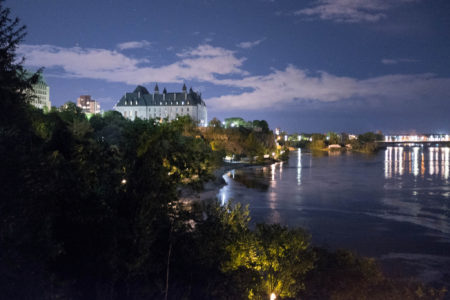Category: Ottawa
Posts about Canada’s capital city, and the experience of living there
Supreme Court of Canada
Milan, Yotam, Mehrzad, and Andrea
University of Ottawa to divest
This evening, the following motion was passed at the University of Ottawa:
The board should ask the finance and treasury committee to do the following:
- Develop a strategy to shift Ottawa fossil fuel related investments towards investments and enterprises, especially those in Canada, involved in creating and selling technologies of the future, including renewable energy and other clean technology solutions.
- Determine a reasonable time period within which that shift can occur
- Report to the board annually starting in the fall of 2017 on its progress seeking further direction as it may require
The exec committee further recommends the board reassess this strategy to determine whether market conditions or any other factors require a change in this strategy.
Obviously the team there deserves huge congratulations for their success. Every institution that takes action makes it easier for campaigns elsewhere to succeed, and harder for opponents to argue that taking action is too risky or not necessary.
That being said, this motion is arguably similarly vague to what U of T decided (although they are admittedly not putting UTAM in charge of implementation). The U of T campaign could have taken a radically different approach to the decision here and portrayed it as a partial success building toward something adequate. Such a response would have had to be agreed in advance, however, and given the mood of the U of T group may not have been possible. Even suggesting it may have exacerbated the deep disagreements about what sort of tactics and messaging are desirable and how success should be measured.
Naviger’s Barn Raising
My friend Andrea Simms-Karp – whose excellent previous albums include Sleeper and Hibernation Nation – has a new album available to stream for free or download for whatever price you choose: Barn Raising.
All the tracks feature her impressive vocals, most are her songwriting, and I have been enjoying it thoroughly. I especially like “Dolly Cassette“.
Contemplating the Climate Welcome
If I can pull it off in the midst of gathering grading, I am tempted to go to Ottawa for three days to participate in most of the Climate Welcome which is being organized for Prime Minister Justin Trudeau:
The Climate Welcome protest, organized by 350.org Canada, is modeled on the 2011 Tar Sands Action sit-ins at the White House that led to the arrests of over 1,200 people and helped elevate the Keystone XL pipeline as the largest environmental fight in a generation.
See also: Trudeau’s big test in Paris: oil industry profits or real action on climate change?
It’s a bit odd to see it billed as “organized by 350.org Canada”, since I don’t think that is really an organization so much as one 350.org employee with a Twitter account and Facebook page. If it’s going to be another “grassroots movement to solve the climate crisis”, they are going to need some members and an organizational structure. If that’s starting to happen in Ottawa tomorrow, it could be reason enough to be present.
The Harperman imbroglio
This little song, written by Environment Canada scientist Tony Turner, has received a lot of media attention:
CBC: Harperman case: Can public servants be political activists?
The Guardian: Canada government suspends scientist for folk song about prime minister
Both the song and the public responses point to one of the big unsettled questions about the appropriate conduct of the public service. What are citizens who are employed to serve the public interest meant to do when the country is badly governed by their political bosses?
CPSA 2015 photos
My photos from Ottawa and the 2015 Canadian Political Science Association conference are online.
Tour of Ottawa sights
My Saturday in Ottawa involved a rather comprehensive trek.
Beginning at the home of my friends Andrea and Mehrzad, I walked up Booth Street – past the first apartment I rented in town and the War Museum – and across the Chaudiere Bridge to the Terrasses de la Chaudière complex which includes Environment Canada headquarters.
On the Quebec side, I then walked to the Museum of Civilization, which has been rebranded by the Harper government as the Canadian Museum of History. I then crossed the Alexandra bridge back into Ontario, putting me near the National Gallery. I walked through Major’s Hill Park and crossed the Rideau Canal near the Chateau Laurier. I then entered Parliament Hill, walking the scenic northern edge, looking out over all the major government buildings of the National Capital Region.
I carried on west, walking around the Supreme Court, before heading east again to buy a ticket for the guided tour of Centre Block. While near Parliament Hill, I had a peek at the building where I used to work for the Privy Council Office, along with the Blackburn Building (home of the PCO library) and the Langevin Block (home of the Prime Minister’s Office).
I then walked through the downtown core, mostly along Bank Street, getting a peek at the new Venus Envy location before diverting west down Somerset. I also had a quick peek at the headquarters of the Department of Finance and Treasury Board Secretariat. I also talked to some not-especially-interested salespeople at Henry’s cameras about the relative merits of the 6D and 5D Mk III.
All through the walk, I was struck by how small a place Ottawa is. Having spent five years working there, every neighbourhood is peppered with memories and (at least on a pleasant summer’s day) they can all be walked to quite easily.
I walked down Somerset all the way back to the Booth neighbourhood and said hello to Andrea’s hilarious dogs before following the river back to Parliament Hill for my tour. The guided tour included the elegant corridors and atriums of Centre Block, committee rooms, the senate, and the extremely beautiful Library of Parliament.
After the tour, I walked up Elgin Street, passing the pub where I used to do trivia on a team of tax economists on Tuesday nights. I headed south to the Museum of Nature before having a look at the much-developed Beaver Barracks complex where I used to live. I then walked back to Bank Street and south through The Glebe to the redeveloped Landsdowne Park.
From there, I visited the Bank Street canal bridge and wandered along the canal and through neighbourhoods as far as Dow’s Lake, before making my way back to Andrea’s via the Natural Resources Canada complex on Booth Street.
Two days in Ottawa
This weekend I went on a short trip to Ottawa to visit my good friends Andrea and Mehrzad. I got quite a few photos, both from meandering between places that were familiar when I lived in Ottawa and of their amusing dogs.



